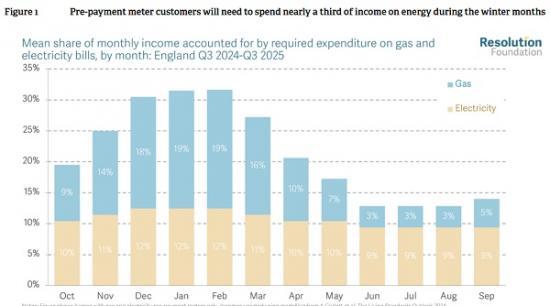The Debate Around Winter Energy Costs Continues To Overlook Those Who Pre-pay For Their Energy
6th January 2025

As Britain moves into deepest darkest winter, the debate around energy costs remains high on the political agenda.
Energy bills remain well above their pre-crisis levels - typical bills are set to be more than £1,700 in Q1 2025 compared with just under £1,300 in late 2021 - and the position of some pensioners has deteriorated following the Government's announcement to means test Winter Fuel Payments.
But with this decision continuing to shape the news agenda - especially as the Scottish Government is forging a different path to the rest of the UK - there is little space for other vulnerable groups to have their voices heard.
In that context we should spare a thought for the 4 million households in the UK that are on pre-payment meters (PPMs), and so pay for their energy at the time of consumption rather than spreading costs accrued in periods of high consumption over the year (as direct debit or standard-credit customers do).
Those on PPMs are heavily concentrated towards the bottom of the income distribution – a quarter of the poorest fifth of English households pre-pay for energy, compared with 1.5 per cent of the richest fifth – and in social and private renting households, where 38 and 18 per cent of families, respectively, are on PPMs, compared to just 2 per cent of owner occupiers.[1]
Further, PPM customers don't have relief from being in less energy-hungry homes: there is an equal share in those with high efficiency as those with low – around 10 per cent across all EPC bands.
Successive governments have acknowledged the vulnerabilities of PPM customers. During the 2022 energy crisis, price cap rates for PPM customers were reduced and ‘forced installations' of PPMs were halted (typically these were made where a household had fallen behind on their energy bills).
More recently, Ofgem has begun consulting on proposals to further equalise charges between households with different payment regimes, and to "raise debt standards" such that fewer customers are shunted onto PPMs when they fall behind on their bills (as well as writing off some debt accrued during recent years). But these actions fall short of proper protection for the section of society most exposed to high energy costs, who are already battling through another winter of real struggle.
PPM customers face a huge amount of volatility in energy spending
It's hard to overstate the seasonal impacts of energy costs on the living standards of PPM customers. Spending – particularly on heating – is highly concentrated during the coldest time of the year, with 78 per cent of heating demand occurring between October and March, and 46 per cent in the first quarter of the year alone. This seasonal spike forces families to either spend a very high proportion of their income to keep warm, or to endure cold living conditions that bring with them significant health impacts.
As Figure 1 shows, the amount of energy that PPM customers need to consume to maintain a reasonable standard of warmth and electricity use will – on average – be more than 30 per cent of their incomes during December, January and February – a figure that falls by close to two-thirds (to around 12 per cent) during the summer.
Read more at Resolution Foundation report HERE
